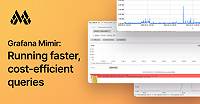Important: This documentation is about an older version. It's relevant only to the release noted, many of the features and functions have been updated or replaced. Please view the current version.
Configure TSDB block upload
Grafana Mimir supports uploading of historic TSDB blocks, sourced from Prometheus, Cortex, or even other Grafana Mimir installations. Upload from Thanos is currently not supported; for more information, see Known limitations of TSDB block upload.
To make performing block upload simple, we’ve built support for it into Mimir’s CLI tool, mimirtool. For more information, see mimirtool backfill.
Block upload is still considered experimental and is therefore disabled by default. You can enable it via the -compactor.block-upload-enabled
CLI flag, or via the corresponding limits.compactor_block_upload_enabled configuration parameter:
limits:
# Enable TSDB block upload
compactor_block_upload_enabled: trueEnable TSDB block upload per tenant
If your Grafana Mimir has multi-tenancy enabled, you can still use the preceding method to enable TSDB block upload for all tenants. If instead you wish to enable it per tenant, you can use the runtime configuration to set a per-tenant override:
- Enable runtime configuration.
- Add an override for the tenant that should have TSDB block upload enabled:
overrides:
tenant1:
compactor_block_upload_enabled: trueKnown limitations of TSDB block upload
Thanos blocks cannot be uploaded
Because Thanos blocks contain unsupported labels among their metadata, they cannot be uploaded.
For information about limitations that relate to importing blocks from Thanos as well as existing workarounds, see Migrating from Thanos or Prometheus to Grafana Mimir.
No validation on imported blocks
Grafana Mimir does not validate that the uploaded blocks are well-formed. This means that users could upload malformed blocks to Grafana Mimir. These malformed blocks could potentially cause problems on the Mimir query path or for the operation of Mimir’s compactor component.
We intend to add validation of uploaded blocks in a future release, which would allow us to identify and reject malformed blocks at upload time and prevent any downstream impact to Grafana Mimir.
The results-cache needs flushing
After uploading one or more blocks, the results-cache needs flushing. The reason is that Grafana Mimir caches query results for queries that don’t touch the most recent 10 minutes of data. After uploading blocks however, queries may return different results (because new data was uploaded). Therefore cached results may be wrong, meaning the cache should manually be flushed after uploading blocks.
Blocks that are too new will not be queryable until later
When queriers receive a query for a given [start, end] period, they consult this period to decide whether to read
data from storage, ingesters, or both. Say -querier.query-store-after is set to 12h. It means that a query
[now-13h, now] will read data from storage. But a query [now-5h, now] will not. If a user uploads blocks that are
“too new”, the querier may not query them, because it is configured to only query ingesters for “fresh” time ranges.


